child restraint NISSAN 370Z 2020 Owner´s Manual
[x] Cancel search | Manufacturer: NISSAN, Model Year: 2020, Model line: 370Z, Model: NISSAN 370Z 2020Pages: 455, PDF Size: 2.22 MB
Page 52 of 455
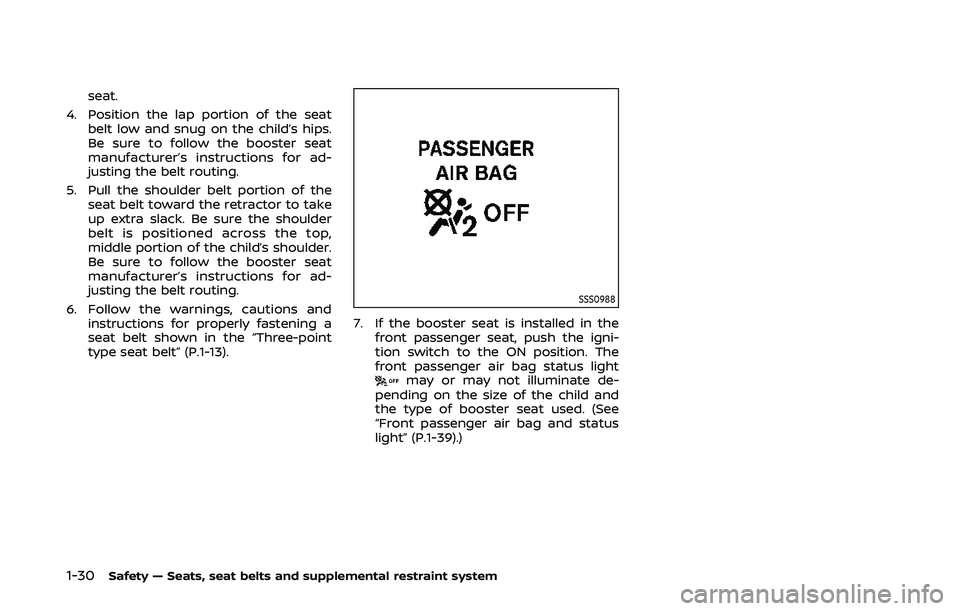
1-30Safety — Seats, seat belts and supplemental restraint system
seat.
4. Position the lap portion of the seat belt low and snug on the child’s hips.
Be sure to follow the booster seat
manufacturer’s instructions for ad-
justing the belt routing.
5. Pull the shoulder belt portion of the seat belt toward the retractor to take
up extra slack. Be sure the shoulder
belt is positioned across the top,
middle portion of the child’s shoulder.
Be sure to follow the booster seat
manufacturer’s instructions for ad-
justing the belt routing.
6. Follow the warnings, cautions and instructions for properly fastening a
seat belt shown in the “Three-point
type seat belt” (P.1-13).
SSS0988
7. If the booster seat is installed in thefront passenger seat, push the igni-
tion switch to the ON position. The
front passenger air bag status light
may or may not illuminate de-
pending on the size of the child and
the type of booster seat used. (See
“Front passenger air bag and status
light” (P.1-39).)
Page 56 of 455
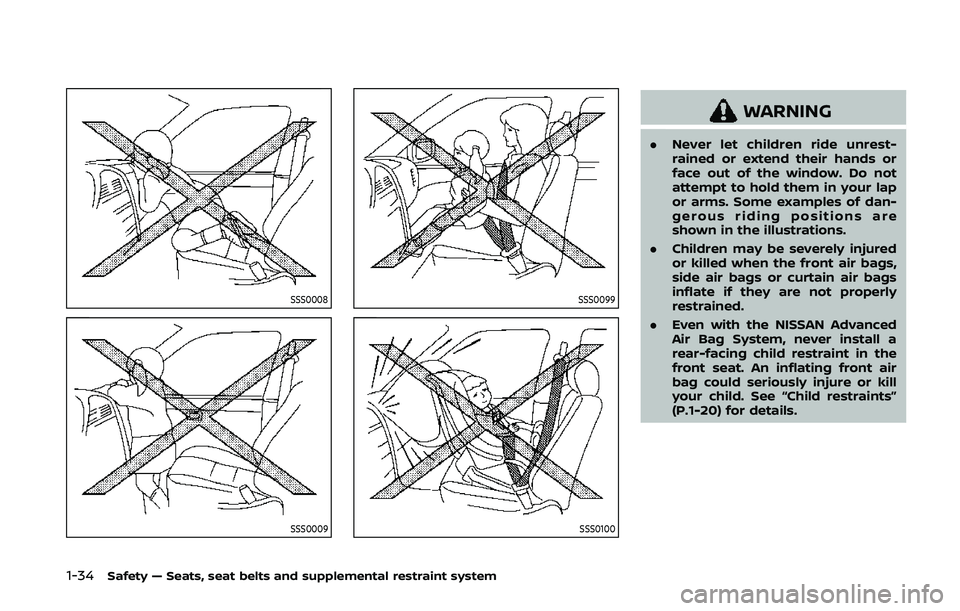
1-34Safety — Seats, seat belts and supplemental restraint system
SSS0008
SSS0009
SSS0099
SSS0100
WARNING
.Never let children ride unrest-
rained or extend their hands or
face out of the window. Do not
attempt to hold them in your lap
or arms. Some examples of dan-
gerous riding positions are
shown in the illustrations.
. Children may be severely injured
or killed when the front air bags,
side air bags or curtain air bags
inflate if they are not properly
restrained.
. Even with the NISSAN Advanced
Air Bag System, never install a
rear-facing child restraint in the
front seat. An inflating front air
bag could seriously injure or kill
your child. See “Child restraints”
(P.1-20) for details.
Page 61 of 455
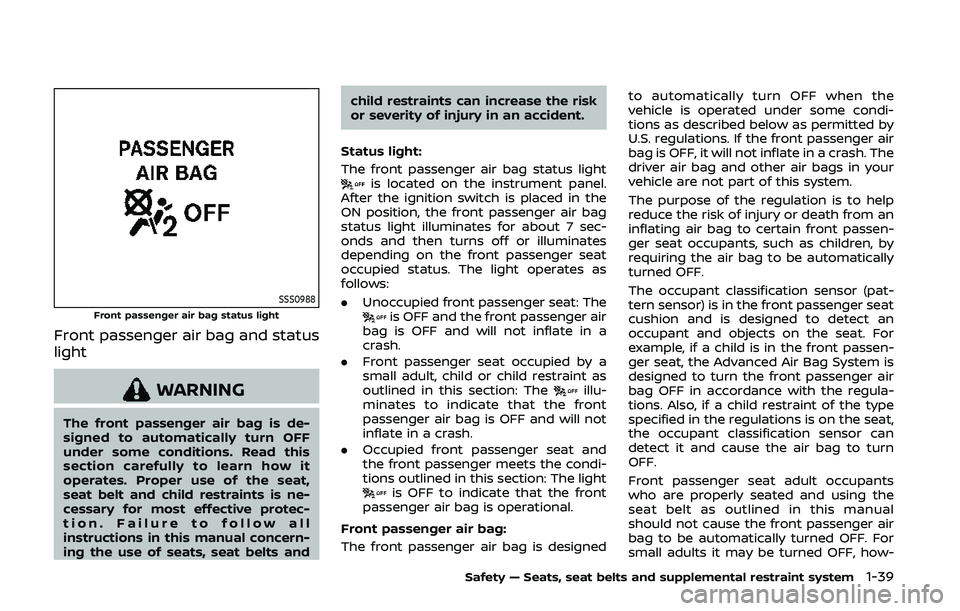
SSS0988Front passenger air bag status light
Front passenger air bag and status
light
WARNING
The front passenger air bag is de-
signed to automatically turn OFF
under some conditions. Read this
section carefully to learn how it
operates. Proper use of the seat,
seat belt and child restraints is ne-
cessary for most effective protec-
tion. Failure to follow all
instructions in this manual concern-
ing the use of seats, seat belts andchild restraints can increase the risk
or severity of injury in an accident.
Status light:
The front passenger air bag status light
is located on the instrument panel.
After the ignition switch is placed in the
ON position, the front passenger air bag
status light illuminates for about 7 sec-
onds and then turns off or illuminates
depending on the front passenger seat
occupied status. The light operates as
follows:
. Unoccupied front passenger seat: The
is OFF and the front passenger air
bag is OFF and will not inflate in a
crash.
. Front passenger seat occupied by a
small adult, child or child restraint as
outlined in this section: The
illu-
minates to indicate that the front
passenger air bag is OFF and will not
inflate in a crash.
. Occupied front passenger seat and
the front passenger meets the condi-
tions outlined in this section: The light
is OFF to indicate that the front
passenger air bag is operational.
Front passenger air bag:
The front passenger air bag is designed to automatically turn OFF when the
vehicle is operated under some condi-
tions as described below as permitted by
U.S. regulations. If the front passenger air
bag is OFF, it will not inflate in a crash. The
driver air bag and other air bags in your
vehicle are not part of this system.
The purpose of the regulation is to help
reduce the risk of injury or death from an
inflating air bag to certain front passen-
ger seat occupants, such as children, by
requiring the air bag to be automatically
turned OFF.
The occupant classification sensor (pat-
tern sensor) is in the front passenger seat
cushion and is designed to detect an
occupant and objects on the seat. For
example, if a child is in the front passen-
ger seat, the Advanced Air Bag System is
designed to turn the front passenger air
bag OFF in accordance with the regula-
tions. Also, if a child restraint of the type
specified in the regulations is on the seat,
the occupant classification sensor can
detect it and cause the air bag to turn
OFF.
Front passenger seat adult occupants
who are properly seated and using the
seat belt as outlined in this manual
should not cause the front passenger air
bag to be automatically turned OFF. For
small adults it may be turned OFF, how-
Safety — Seats, seat belts and supplemental restraint system1-39
Page 62 of 455
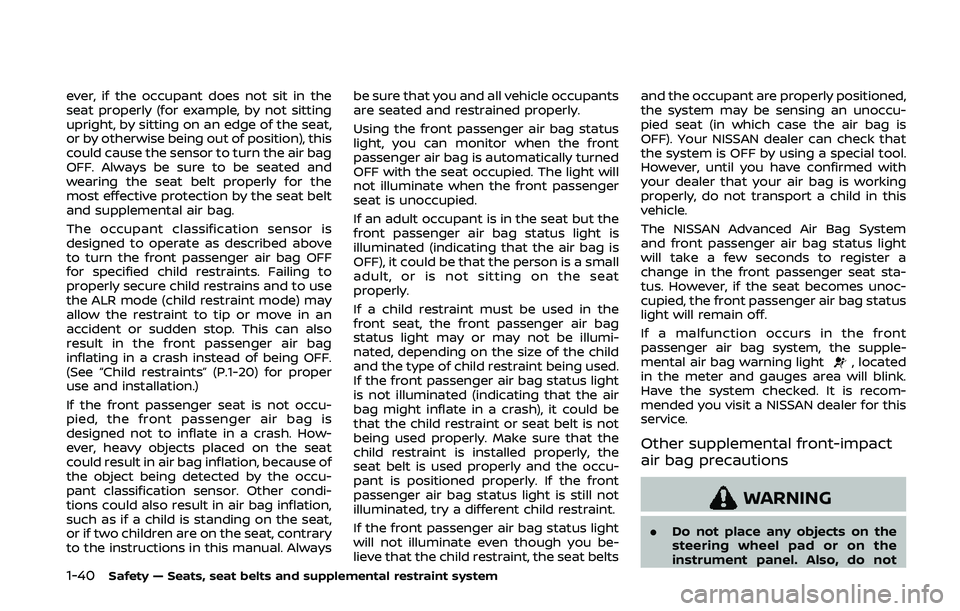
1-40Safety — Seats, seat belts and supplemental restraint system
ever, if the occupant does not sit in the
seat properly (for example, by not sitting
upright, by sitting on an edge of the seat,
or by otherwise being out of position), this
could cause the sensor to turn the air bag
OFF. Always be sure to be seated and
wearing the seat belt properly for the
most effective protection by the seat belt
and supplemental air bag.
The occupant classification sensor is
designed to operate as described above
to turn the front passenger air bag OFF
for specified child restraints. Failing to
properly secure child restrains and to use
the ALR mode (child restraint mode) may
allow the restraint to tip or move in an
accident or sudden stop. This can also
result in the front passenger air bag
inflating in a crash instead of being OFF.
(See “Child restraints” (P.1-20) for proper
use and installation.)
If the front passenger seat is not occu-
pied, the front passenger air bag is
designed not to inflate in a crash. How-
ever, heavy objects placed on the seat
could result in air bag inflation, because of
the object being detected by the occu-
pant classification sensor. Other condi-
tions could also result in air bag inflation,
such as if a child is standing on the seat,
or if two children are on the seat, contrary
to the instructions in this manual. Alwaysbe sure that you and all vehicle occupants
are seated and restrained properly.
Using the front passenger air bag status
light, you can monitor when the front
passenger air bag is automatically turned
OFF with the seat occupied. The light will
not illuminate when the front passenger
seat is unoccupied.
If an adult occupant is in the seat but the
front passenger air bag status light is
illuminated (indicating that the air bag is
OFF), it could be that the person is a small
adult, or is not sitting on the seat
properly.
If a child restraint must be used in the
front seat, the front passenger air bag
status light may or may not be illumi-
nated, depending on the size of the child
and the type of child restraint being used.
If the front passenger air bag status light
is not illuminated (indicating that the air
bag might inflate in a crash), it could be
that the child restraint or seat belt is not
being used properly. Make sure that the
child restraint is installed properly, the
seat belt is used properly and the occu-
pant is positioned properly. If the front
passenger air bag status light is still not
illuminated, try a different child restraint.
If the front passenger air bag status light
will not illuminate even though you be-
lieve that the child restraint, the seat beltsand the occupant are properly positioned,
the system may be sensing an unoccu-
pied seat (in which case the air bag is
OFF). Your NISSAN dealer can check that
the system is OFF by using a special tool.
However, until you have confirmed with
your dealer that your air bag is working
properly, do not transport a child in this
vehicle.
The NISSAN Advanced Air Bag System
and front passenger air bag status light
will take a few seconds to register a
change in the front passenger seat sta-
tus. However, if the seat becomes unoc-
cupied, the front passenger air bag status
light will remain off.
If a malfunction occurs in the front
passenger air bag system, the supple-
mental air bag warning light
, located
in the meter and gauges area will blink.
Have the system checked. It is recom-
mended you visit a NISSAN dealer for this
service.
Other supplemental front-impact
air bag precautions
WARNING
. Do not place any objects on the
steering wheel pad or on the
instrument panel. Also, do not
Page 67 of 455
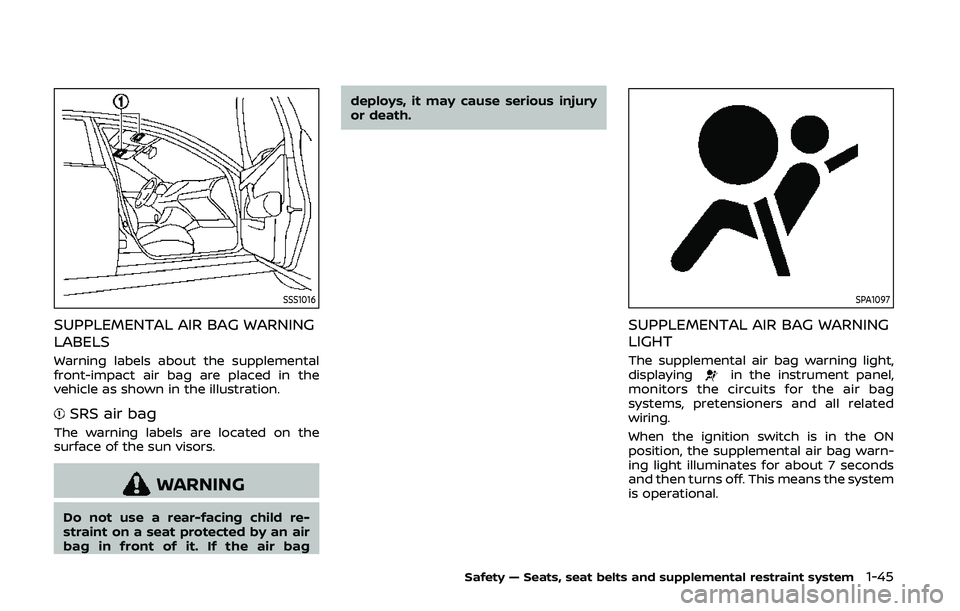
SSS1016
SUPPLEMENTAL AIR BAG WARNING
LABELS
Warning labels about the supplemental
front-impact air bag are placed in the
vehicle as shown in the illustration.
SRS air bag
The warning labels are located on the
surface of the sun visors.
WARNING
Do not use a rear-facing child re-
straint on a seat protected by an air
bag in front of it. If the air bagdeploys, it may cause serious injury
or death.
SPA1097
SUPPLEMENTAL AIR BAG WARNING
LIGHT
The supplemental air bag warning light,
displayingin the instrument panel,
monitors the circuits for the air bag
systems, pretensioners and all related
wiring.
When the ignition switch is in the ON
position, the supplemental air bag warn-
ing light illuminates for about 7 seconds
and then turns off. This means the system
is operational.
Safety — Seats, seat belts and supplemental restraint system1-45
Page 115 of 455
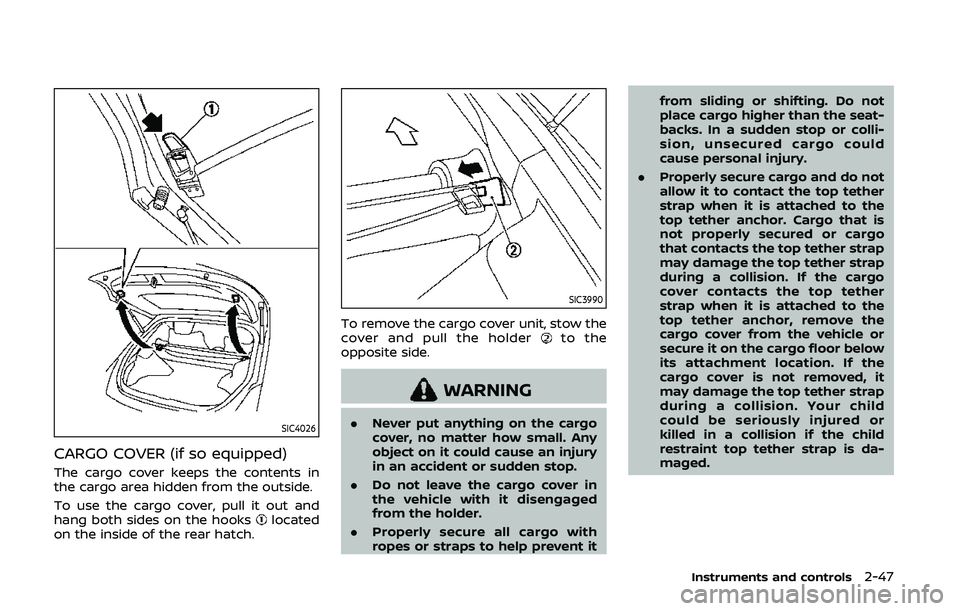
SIC4026
CARGO COVER (if so equipped)
The cargo cover keeps the contents in
the cargo area hidden from the outside.
To use the cargo cover, pull it out and
hang both sides on the hooks
located
on the inside of the rear hatch.
SIC3990
To remove the cargo cover unit, stow the
cover and pull the holderto the
opposite side.
WARNING
. Never put anything on the cargo
cover, no matter how small. Any
object on it could cause an injury
in an accident or sudden stop.
. Do not leave the cargo cover in
the vehicle with it disengaged
from the holder.
. Properly secure all cargo with
ropes or straps to help prevent it from sliding or shifting. Do not
place cargo higher than the seat-
backs. In a sudden stop or colli-
sion, unsecured cargo could
cause personal injury.
. Properly secure cargo and do not
allow it to contact the top tether
strap when it is attached to the
top tether anchor. Cargo that is
not properly secured or cargo
that contacts the top tether strap
may damage the top tether strap
during a collision. If the cargo
cover contacts the top tether
strap when it is attached to the
top tether anchor, remove the
cargo cover from the vehicle or
secure it on the cargo floor below
its attachment location. If the
cargo cover is not removed, it
may damage the top tether strap
during a collision. Your child
could be seriously injured or
killed in a collision if the child
restraint top tether strap is da-
maged.
Instruments and controls2-47
Page 149 of 455
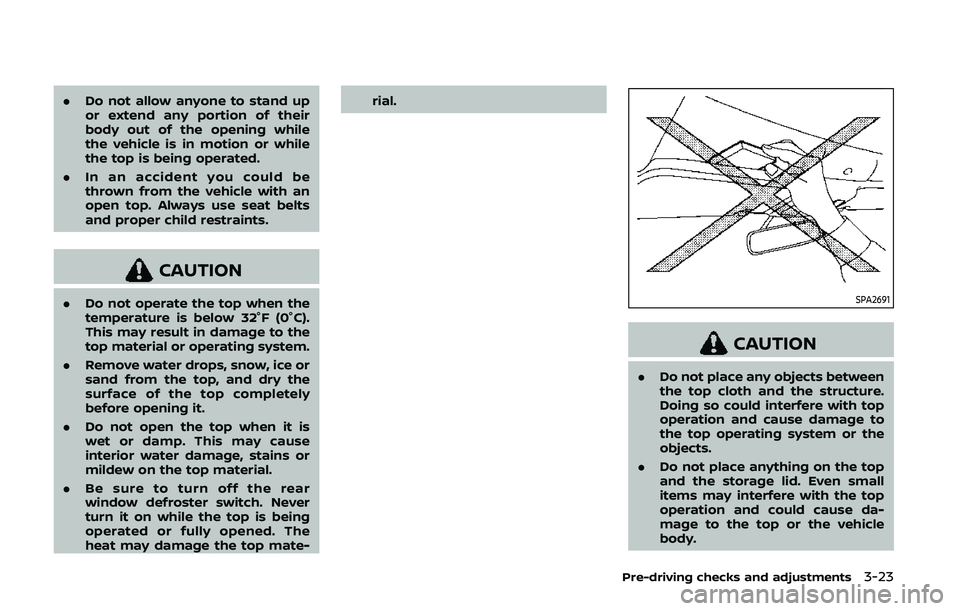
.Do not allow anyone to stand up
or extend any portion of their
body out of the opening while
the vehicle is in motion or while
the top is being operated.
. In an accident you could be
thrown from the vehicle with an
open top. Always use seat belts
and proper child restraints.
CAUTION
.Do not operate the top when the
temperature is below 32°F (0°C).
This may result in damage to the
top material or operating system.
. Remove water drops, snow, ice or
sand from the top, and dry the
surface of the top completely
before opening it.
. Do not open the top when it is
wet or damp. This may cause
interior water damage, stains or
mildew on the top material.
. Be sure to turn off the rear
window defroster switch. Never
turn it on while the top is being
operated or fully opened. The
heat may damage the top mate- rial.SPA2691
CAUTION
.
Do not place any objects between
the top cloth and the structure.
Doing so could interfere with top
operation and cause damage to
the top operating system or the
objects.
. Do not place anything on the top
and the storage lid. Even small
items may interfere with the top
operation and could cause da-
mage to the top or the vehicle
body.
Pre-driving checks and adjustments3-23
Page 447 of 455
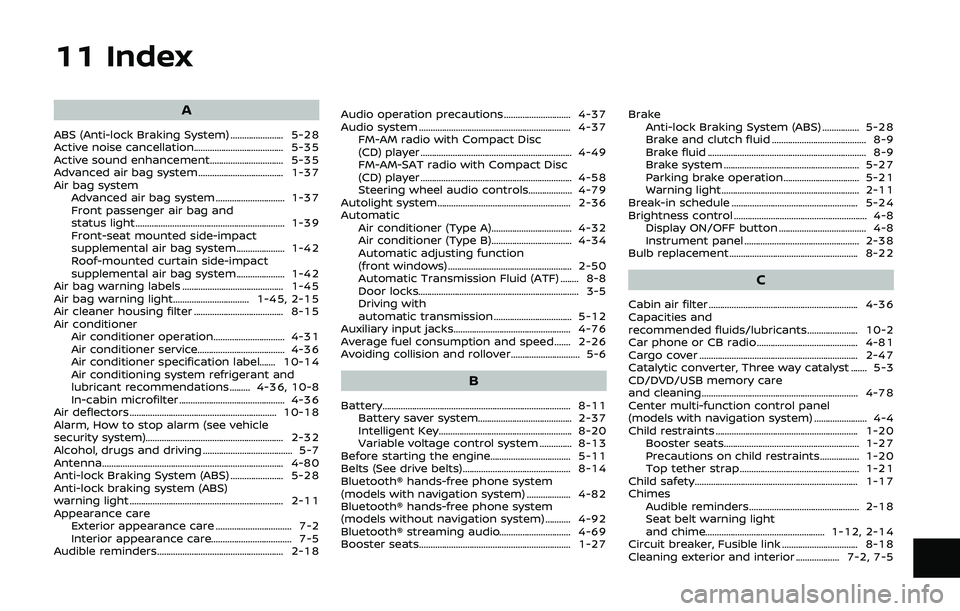
11 Index
A
ABS (Anti-lock Braking System) ....................... 5-28
Active noise cancellation....................................... 5-35
Active sound enhancement................................ 5-35
Advanced air bag system ..................................... 1-37
Air bag systemAdvanced air bag system .............................. 1-37
Front passenger air bag and
status light................................................................. 1-39
Front-seat mounted side-impact
supplemental air bag system..................... 1-42
Roof-mounted curtain side-impact
supplemental air bag system..................... 1-42
Air bag warning labels ............................................ 1-45
Air bag warning light................................. 1-45, 2-15
Air cleaner housing filter ....................................... 8-15
Air conditioner Air conditioner operation............................... 4-31
Air conditioner service...................................... 4-36
Air conditioner specification label....... 10-14
Air conditioning system refrigerant and
lubricant recommendations ......... 4-36, 10-8
In-cabin microfilter .............................................. 4-36
Air deflectors ................................................................ 10-18
Alarm, How to stop alarm (see vehicle
security system)............................................................ 2-32
Alcohol, drugs and driving ....................................... 5-7
Antenna........................................................................\
....... 4-80
Anti-lock Braking System (ABS) ....................... 5-28
Anti-lock braking system (ABS)
warning light ................................................................... 2-11
Appearance care Exterior appearance care ................................. 7-2
Interior appearance care................................... 7-5
Audible reminders....................................................... 2-18 Audio operation precautions ............................. 4-37
Audio system .................................................................. 4-37
FM-AM radio with Compact Disc
(CD) player .................................................................. 4-49
FM-AM-SAT radio with Compact Disc
(CD) player .................................................................. 4-58
Steering wheel audio controls................... 4-79
Autolight system.......................................................... 2-36
Automatic Air conditioner (Type A)................................... 4-32
Air conditioner (Type B)................................... 4-34
Automatic adjusting function
(front windows) ...................................................... 2-50
Automatic Transmission Fluid (ATF) ........ 8-8
Door locks...................................................................... 3-5
Driving with
automatic transmission .................................. 5-12
Auxiliary input jacks................................................... 4-76
Average fuel consumption and speed ....... 2-26
Avoiding collision and rollover.............................. 5-6
B
Battery........................................................................\
.......... 8-11 Battery saver system......................................... 2-37
Intelligent Key.......................................................... 8-20
Variable voltage control system .............. 8-13
Before starting the engine................................... 5-11
Belts (See drive belts)............................................... 8-14
Bluetooth® hands-free phone system
(models with navigation system) ................... 4-82
Bluetooth® hands-free phone system
(models without navigation system) ........... 4-92
Bluetooth® streaming audio............................... 4-69
Booster seats.................................................................. 1-27 Brake
Anti-lock Braking System (ABS) ................ 5-28
Brake and clutch fluid ......................................... 8-9
Brake fluid ..................................................................... 8-9
Brake system ........................................................... 5-27
Parking brake operation................................. 5-21
Warning light............................................................ 2-11
Break-in schedule ....................................................... 5-24
Brightness control .......................................................... 4-8 Display ON/OFF button ...................................... 4-8
Instrument panel .................................................. 2-38
Bulb replacement ........................................................ 8-22
C
Cabin air filter ................................................................. 4-36
Capacities and
recommended fluids/lubricants...................... 10-2
Car phone or CB radio ............................................ 4-81
Cargo cover ..................................................................... 2-47
Catalytic converter, Three way catalyst ....... 5-3
CD/DVD/USB memory care
and cleaning.................................................................... 4-78
Center multi-function control panel
(models with navigation system) ....................... 4-4
Child restraints .............................................................. 1-20 Booster seats........................................................... 1-27
Precautions on child restraints................. 1-20
Top tether strap .................................................... 1-21
Child safety....................................................................... 1-17
Chimes Audible reminders................................................ 2-18
Seat belt warning light
and chime.................................................... 1-12, 2-14
Circuit breaker, Fusible link ................................. 8-18
Cleaning exterior and interior ................... 7-2, 7-5
Page 451 of 455
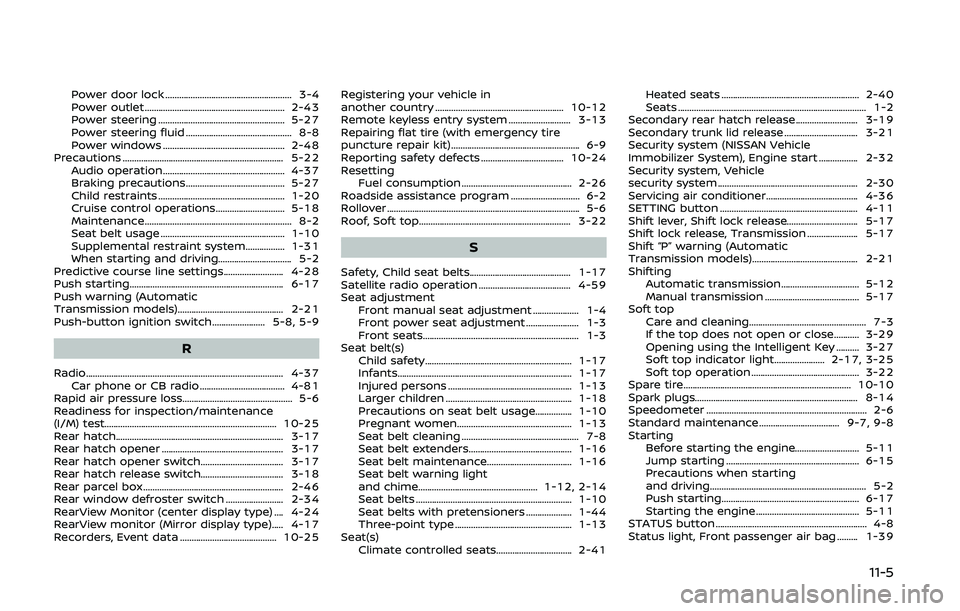
Power door lock ....................................................... 3-4
Power outlet............................................................. 2-43
Power steering ....................................................... 5-27
Power steering fluid .............................................. 8-8
Power windows ..................................................... 2-48
Precautions ...................................................................... 5-22 Audio operation..................................................... 4-37
Braking precautions........................................... 5-27
Child restraints ....................................................... 1-20
Cruise control operations.............................. 5-18
Maintenance................................................................ 8-2
Seat belt usage ...................................................... 1-10
Supplemental restraint system................. 1-31
When starting and driving................................ 5-2
Predictive course line settings.......................... 4-28
Push starting................................................................\
... 6-17
Push warning (Automatic
Transmission models).............................................. 2-21
Push-button ignition switch....................... 5-8, 5-9
R
Radio........................................................................\
.............. 4-37 Car phone or CB radio ..................................... 4-81
Rapid air pressure loss................................................ 5-6
Readiness for inspection/maintenance
(I/M) test........................................................................\
... 10-25
Rear hatch........................................................................\
. 3-17
Rear hatch opener ..................................................... 3-17
Rear hatch opener switch.................................... 3-17
Rear hatch release switch.................................... 3-18
Rear parcel box ............................................................. 2-46
Rear window defroster switch ......................... 2-34
RearView Monitor (center display type) .... 4-24
RearView monitor (Mirror display type)..... 4-17
Recorders, Event data .......................................... 10-25 Registering your vehicle in
another country ........................................................ 10-12
Remote keyless entry system ........................... 3-13
Repairing flat tire (with emergency tire
puncture repair kit) ........................................................ 6-9
Reporting safety defects .................................... 10-24
Resetting
Fuel consumption ................................................ 2-26
Roadside assistance program .............................. 6-2
Rollover ........................................................................\
............ 5-6
Roof, Soft top.................................................................. 3-22
S
Safety, Child seat belts............................................ 1-17
Satellite radio operation ........................................ 4-59
Seat adjustment Front manual seat adjustment .................... 1-4
Front power seat adjustment ....................... 1-3
Front seats.................................................................... 1-3
Seat belt(s)
Child safety................................................................ 1-17
Infants.................................................................\
........... 1-17
Injured persons ...................................................... 1-13
Larger children ....................................................... 1-18
Precautions on seat belt usage................ 1-10
Pregnant women.................................................. 1-13
Seat belt cleaning ................................................... 7-8
Seat belt extenders............................................. 1-16
Seat belt maintenance..................................... 1-16
Seat belt warning light
and chime.................................................... 1-12, 2-14
Seat belts .................................................................... 1-10
Seat belts with pretensioners .................... 1-44
Three-point type ................................................... 1-13
Seat(s) Climate controlled seats................................. 2-41 Heated seats ............................................................ 2-40
Seats ........................................................................\
.......... 1-2
Secondary rear hatch release........................... 3-19
Secondary trunk lid release ................................ 3-21
Security system (NISSAN Vehicle
Immobilizer System), Engine start ................. 2-32
Security system, Vehicle
security system ............................................................. 2-30
Servicing air conditioner........................................ 4-36
SETTING button ............................................................ 4-11
Shift lever, Shift lock release............................... 5-17
Shift lock release, Transmission ...................... 5-17
Shift “P” warning (Automatic
Transmission models).............................................. 2-21
Shifting Automatic transmission.................................. 5-12
Manual transmission ......................................... 5-17
Soft top Care and cleaning................................................... 7-3
If the top does not open or close........... 3-29
Opening using the Intelligent Key .......... 3-27
Soft top indicator light...................... 2-17, 3-25
Soft top operation ............................................... 3-22
Spare tire........................................................................\
. 10-10
Spark plugs....................................................................... 8-14
Speedometer ...................................................................... 2-6
Standard maintenance ................................... 9-7, 9-8
Starting Before starting the engine............................ 5-11
Jump starting .......................................................... 6-15
Precautions when starting
and driving.................................................................... 5-2
Push starting............................................................ 6-17
Starting the engine............................................. 5-11
STATUS button .................................................................. 4-8
Status light, Front passenger air bag ......... 1-39
11-5